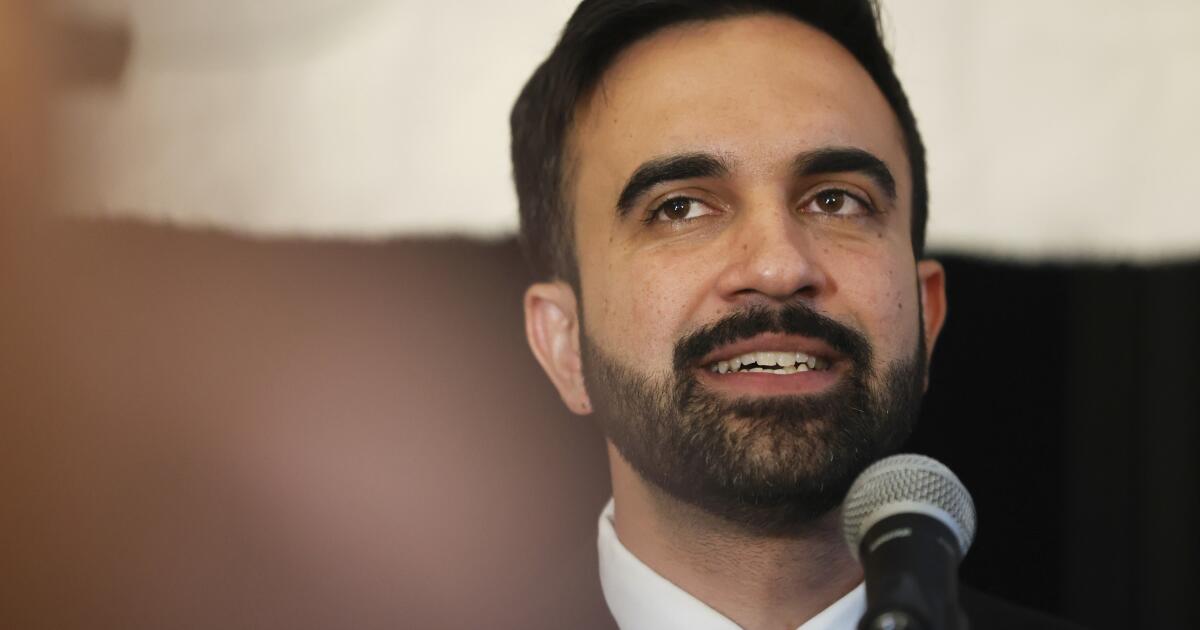Contributor: How could ranked-choice voting reshape California politics?
Last month, New York City’s mayoral race drew national attention when Democratic Socialist Zohran Mamdani secured a stunning victory over former governor and political veteran Andrew Cuomo in the Democratic primary, thanks to the relatively new system of ranked-choice voting. Less noticed were the 28 contested New York City Council races on the same ballot, 10 of which also had no candidate receiving more than 50% of the vote.
In most places, including in most of California, such messy results would trigger a costly runoff between the top two finishers in each race. But not in New York City, where voters rank every candidate in order of preference on their ballots. If no one receives more than 50% of the first-choice votes, whichever candidate received the fewest first-choice votes is eliminated, and voters whose ballots had that person in the top position are then counted as supporters of their second choice. This process of elimination and consolidation continues until one candidate receives more than 50% of the vote.
Perhaps Mamdani would have won the primary in a runoff against Cuomo, but he didn’t have to. This voting system reflected the will of the people without dragging out campaign season or asking voters to head to the polls an extra time.
Advocates say ranked-choice voting ensures your vote isn’t wasted if your top choice is eliminated. Proponents also contend that the system discourages negative campaigning (instead fostering cross-endorsements), improves representation for women and people of color, promotes more viable competition, reduces election costs and eliminates the “spoiler effect” from vote siphoning.
Ranked-choice voting is gaining traction, particularly in U.S. cities. Currently, 63 jurisdictions nationwide use some form of ranked-choice voting, including seven in California: Albany, Berkeley, Oakland, Redondo Beach, San Francisco and San Leandro.
Polling shows strong support for ranked-choice voting among residents of California cities that have it, and most of those cities increased the diversity of their governing bodies after implementation. These systems have already saved money for California taxpayers by eliminating costly runoff elections.
What would change if California implemented ranked-choice voting for state offices, or if general elections in the city of Los Angeles were decided this way? It would play out differently than in New York.
Unlike New York, which holds party primaries, most California jurisdictions hold nonpartisan primary elections in which all parties run on the same ticket — known as a top-two or jungle primary. This means when a candidate loses in a state or local primary, they can’t just switch parties or run as an independent to get on the general election ballot, as Cuomo now could.
California’s nonpartisan elections also mean that a candidate’s party affiliation plays a competitive role in primaries, unlike in New York City. Because of this, candidates will sometimes strategically register with the dominant party before they run in California, as Rick Caruso did in 2022. This wouldn’t necessarily change under ranked-choice voting, but some candidates might feel less inclined to employ this tactic if they think they have a chance at getting a voter’s second- or third-choice votes while running as a candidate of their preferred party.
There are two other crucial differences between California elections and New York races, one at the local level and one at the state level.
Locally, most jurisdictions, including the city of Los Angeles, hold a general election only if no candidate wins more than 50% of the primary vote. Thus ranked-choice voting would eliminate the need for primary elections altogether in most California races. This would save jurisdictions money and probably increase voter turnout, given that more people traditionally vote in general elections than in primaries.
In contrast, California uses a top-two primary system for most state and federal races, which advances the top two vote-getters, regardless of party affiliation or margin of victory, to the general election. While this avoids costly runoffs, it often results in one-party general elections, especially in heavily partisan districts. Ranked-choice voting wouldn’t prevent that scenario, but it might give underrepresented parties a better shot at advancing in competitive races.
Less known is whether ranked-choice voting would alter the political makeup of representation if broadly implemented in California. Strategic crossover voting — in which Republicans and Democrats rank moderate candidates from the other party — could lead to more centrist outcomes. Likewise, in areas where one party dominates, consistent second-choice support for moderate candidates from other parties could move the controlling party toward the center. Conversely, in areas with many hard-left or hard-right voters, ranked-choice voting could push moderates to adopt more extreme positions to gain second- or third-choice support.
The combination of ranked-choice voting with California’s nonpartisan system would likely produce unique strategic incentives and political realignments unimaginable in cities with partisan primaries.
Campaign styles could also change. Candidates may tone down attacks and even form alliances with like-minded rivals, as progressives did in New York, to earn second-choice votes.
Those unknowns may make some state and local leaders hesitant to change the way we vote. After all, those who’ve won office through the current system are often the least eager to change it. But hesitation shouldn’t overshadow the potential benefits: lower costs, broader engagement, more representative outcomes and less divisive politics.
If California is serious about reforming its increasingly expensive and polarized electoral system, ranked-choice voting is worth a closer look.
Sean McMorris is the California Common Cause program manager for transparency, ethics and accountability.

